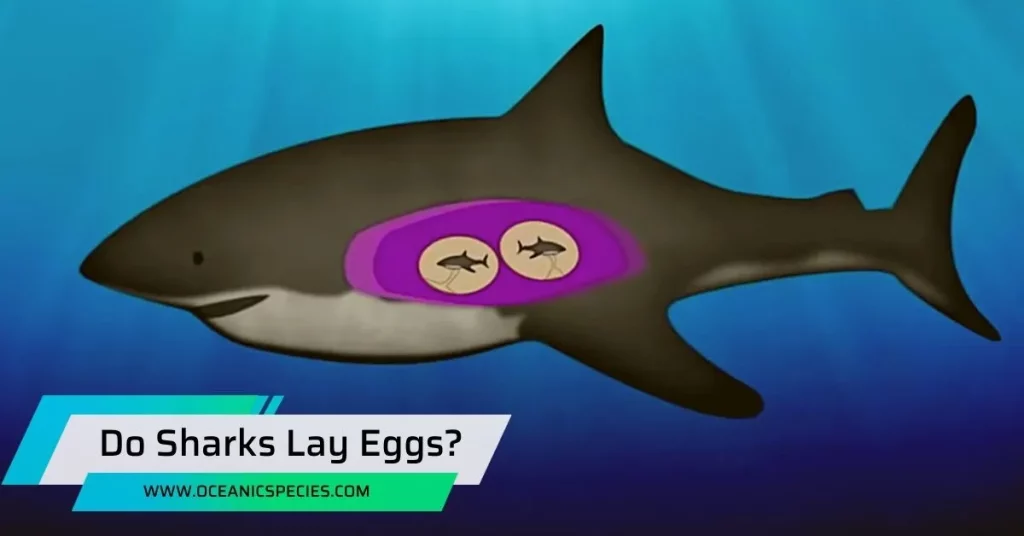Sharks do not lay eggs; instead, they give birth to live young. Sharks are fascinating creatures that have captured the attention and curiosity of people for ages.
One question that often arises when discussing sharks is whether or not they lay eggs. The answer to this question is straightforward: sharks do not lay eggs. Unlike many other species of fish, sharks give birth to live young. This process, known as viviparity, is a unique characteristic of sharks.
While some sharks may lay eggs have a different way of reproducing, the majority of shark species give birth to fully formed pups. We will explore the fascinating world of shark reproduction and delve into the intricate details of how these majestic creatures bring new life into the world. So let’s jump in and discover more about the mysteries of shark birth.
Understanding Shark Reproduction

Different Modes Of Reproduction In The Animal Kingdom
Animals have fascinating ways of reproducing, with each species evolving unique strategies to ensure the survival of their offspring. Some reproduce by laying eggs, while others give birth to live young. Let’s explore the different modes of reproduction in the animal kingdom:
- Sexual reproduction: This is the most common mode of reproduction, involving the fusion of sperm and egg to form a zygote. This method allows for genetic variation and diversity within a species.
- Asexual reproduction: In this mode of reproduction, an organism can produce offspring without the involvement of a mate. Examples include budding, fragmentation, and parthenogenesis.
- Oviparity: This is a form of reproduction where animals lay eggs that develop and hatch outside the mother’s body. Oviparous animals can be found in various groups, such as reptiles, birds, and many species of fish.
- Ovoviviparity: In ovoviviparous reproduction, the eggs hatch inside the mother’s body, and the young are born live. Although the mother provides nourishment during development, there is no direct connection between the mother and offspring.
- Viviparity: Viviparity is another form of live birth, where the mother provides direct nourishment to her developing offspring through a placenta or specialized structures.
Overview Of Unique Reproduction Methods In Sharks

Sharks, being ancient and incredible creatures, have their own unique ways of reproducing that differ from most other fish species. Here is an overview of their intriguing reproductive methods:
- Oviparity in some species: Some shark species, like the port jackson shark, lay distinct egg cases known as “mermaid’s purses.” These tough, leathery cases protect the developing embryos until they are ready to hatch.
- Ovoviviparity in most species: The majority of shark species are ovoviviparous, meaning the embryos develop inside the female’s body, but are nourished by yolk sacs rather than a direct placental connection. The mother eventually gives birth to live young.
- Exceptional cases of viviparity: A few shark species, such as the great white shark and some hammerhead species, exhibit a form of viviparity known as aplacental viviparity. In these cases, there is no placental connection, and the young rely on yolk sacs and possibly cannibalism of siblings to survive.
How Do Sharks Reproduce Compared To Other Species?
Shark reproduction is unique when compared to other animal species, especially when it comes to their ability to produce live young. Here are some key points to understand how sharks reproduce:
- Sharks have a slower reproductive rate compared to many other fish species. They generally have long gestation periods, ranging from several months to a few years, which allows the young to develop more fully before birth.
- The ability of some shark species to store sperm for extended periods enables females to reproduce without a mate. This phenomenon, known as facultative parthenogenesis, allows for the survival of the species even in the absence of males.
- Sharks exhibit various reproductive strategies, such as internal fertilization, laying eggs, and live birth. This flexibility contributes to their resilience and adaptability in different environments.
- The mode of reproduction in sharks is influenced by factors such as predator-prey dynamics, environmental conditions, and the species’ evolutionary history.
Oviparous Sharks: Egg-Laying Wonders
In this section, we will focus on a specific group of sharks known as oviparous sharks, exploring their unique characteristics, the process of egg production, and the importance of egg cases in protecting shark embryos.
Oviparous Sharks: Definition And Characteristics
Oviparous sharks belong to a class of sharks that lay eggs. Unlike other sharks that give birth to live young, oviparous sharks produce eggs externally. After the eggs are laid, they develop and hatch outside the mother’s body. Oviparous sharks include species such as port jackson sharks, swell sharks, and catsharks.
Examining The Process Of Egg Production In Oviparous Sharks
Oviparous sharks go through a fascinating process when it comes to producing eggs. Let’s take a closer look at the steps involved:
- Mating: Oviparous sharks mate through internal fertilization, where the male’s claspers transfer sperm into the female’s reproductive tract.
- Egg development: Once fertilization occurs, the female shark begins the process of creating an egg case. This egg case serves as a protective cover for the developing embryo.
- Egg-laying: Oviparous sharks lay their eggs in safe and secluded locations, often hidden within rocky crevices or attached to underwater structures. The female carefully secures the egg case, ensuring its protection until it hatches.
- Incubation period: The time it takes for oviparous shark eggs to hatch can vary depending on the species, environmental conditions, and water temperature. Some eggs may take a few months, while others may take up to a year to hatch.
The Importance Of Egg Cases In Protecting Shark Embryos
The egg case plays a crucial role in safeguarding the developing shark embryo. Here are a few reasons why egg cases are vital:
- Physical protection: The tough, leathery egg case acts as a shield, providing a barrier against predators, physical damage, and environmental hazards.
- Nutritional support: Inside the egg case, the embryo receives essential nutrients from the surrounding yolk, allowing it to grow and develop.
- Oxygen supply: Egg cases are designed to allow water circulation, ensuring a constant flow of oxygen for the growing embryo.
- Camouflage: Some egg cases have unique shapes and patterns that help them blend into their surroundings, reducing the chances of detection by predators.
Viviparous Sharks: Live Births In The Deep

Viviparity is a fascinating reproductive strategy found in some shark species, where the embryos develop inside the mother’s body until birth. Let’s take a closer look at the definition and features of viviparous sharks:
- Viviparity is the process of giving birth to live young rather than laying eggs. It is the opposite of oviparity, where eggs are laid and hatched externally.
- Viviparous sharks have evolved various mechanisms to support the development and survival of their offspring within the mother’s body.
- These sharks possess specialized structures called placental attachments that aid in the exchange of nutrients, oxygen, and waste products between the mother and the developing embryos.
- The development of these placental attachments allows viviparous sharks to provide their embryos with a more stable and protected environment compared to laying eggs.
- Viviparous species often have a longer gestation period to ensure the embryos have enough time to fully develop before birth.
Are There Any Advantages To Viviparous Reproduction In Sharks?
The evolution of viviparity in sharks offers several advantages over other reproductive strategies. Here are some key advantages:
- Increased survival chances: Viviparous reproduction provides greater protection for the developing embryos, reducing the risk of predation and environmental hazards associated with laying eggs externally.
- Enhanced development: By nourishing the embryos internally, viviparity allows for a longer developmental period, leading to more advanced and better-equipped offspring.
- Adaptability to different habitats: Viviparous sharks can give birth to live young in a wide range of habitats, including deeper and colder waters, where it may not be feasible for egg-laying species.
- Offspring resiliency: Viviparous reproduction allows for the production of fewer but more resilient offspring. This strategy ensures that the resources and energy invested in each offspring have a higher chance of survival and successful growth.
Ovoviviparous Sharks: The Middle Ground
Have you ever wondered whether sharks lay eggs like birds and reptiles, or give birth to live young like mammals? Well, the answer lies somewhere in between. Ovoviviparous sharks, a group of sea creatures, employ a unique reproductive strategy that sets them apart from other animals.
In this section, we will dive into the world of ovoviviparous sharks and unravel the mysteries behind their reproductive process.
Understanding The Unique Reproductive Strategy Of Ovoviviparous Sharks:
Unlike sharks that lay eggs (oviparous) or give live birth (viviparous), ovoviviparous sharks follow a middle ground approach. These sharks produce eggs like oviparous species but retain them internally until they are ready to hatch. The embryos develop inside the female shark’s body, receiving nourishment directly from the yolk sac of the egg. Ovoviviparous sharks provide a safe and protected environment for their developing young, ensuring their survival.
Exploring The Benefits And Challenges Of This Mode Of Reproduction:
The key advantage of ovoviviparity is that it allows the female shark to deliver fully developed pups rather than vulnerable hatchlings. By retaining the eggs inside their body, female sharks provide efficient protection against predators and harsh environmental conditions.
Ovoviviparity facilitates a longer gestation period, which allows the embryos to reach a more advanced stage of development before birth. However, this reproductive strategy also poses certain challenges. Female sharks need to allocate energy to both their own growth and the development of their young.
Instances Of Paternal Care And Protection In Different Shark Species
- Sand tiger sharks (carcharias taurus): Male sand tiger sharks exhibit one of the highest levels of paternal care among shark species. They often mate with multiple females and form temporary aggregations, where pregnant females gather to give birth. Once the female shark has fertilized eggs in her uterus, the male will continue to guard her until birth, protecting the embryos from potential predators.
- Zebra sharks (stegostoma fasciatum): These strikingly patterned sharks engage in a remarkable form of paternal care. During breeding, the male zebra shark uses suction to hold on to the female’s dorsal fin, ensuring successful copulation. After mating, the male continues to stay close to the female, offering protection to the developing embryos.
- Bullhead sharks (heterodontus sp. ): Male bullhead sharks are known for their active involvement in guarding their eggs. They use their muscular pectoral fins to fan oxygen-rich water over the embryos, making sure they receive an adequate oxygen supply. This behavior significantly enhances the survival rate of their offspring.
Frequently Asked Questions
How Do Sharks Reproduce?
Sharks reproduce through internal fertilization, with the male shark inserting his claspers into the female’s reproductive organs.
Are Shark Eggs Left Unattended After They Are Laid?
Yes, most shark eggs are left unattended after they are laid, with the mother’s role typically ending once she lays the eggs.
How Long Does It Take For Shark Eggs To Hatch?
The time it takes for shark eggs to hatch varies depending on the species, but it can range from a few months to over a year.
What Happens To Baby Sharks After They Hatch From The Eggs?
After hatching, baby sharks are on their own and must fend for themselves, as there is no parental care provided. They quickly swim away to find food and avoid predators.
Conclusion
Sharks do not lay eggs, with a few exceptions. While most shark species are viviparous, meaning they give birth to live young, some are ovoviviparous, where the eggs remain in the mother’s body until they hatch. This unique reproductive strategy ensures that shark embryos receive the necessary nutrients and protection while developing.
Examples of ovoviviparous sharks include the great white shark and the bull shark. However, a small number of shark species are indeed oviparous, meaning they lay eggs. These sharks include the bamboo shark and the carpet shark. Understanding the diverse reproductive strategies of sharks helps shed light on their incredible adaptations to various marine environments.
Whether they give birth to live young or lay eggs, sharks have evolved fascinating and efficient methods to ensure the survival of their offspring. The study of shark reproduction continues to fascinate scientists and reveals the remarkable diversity of these ancient creatures.





